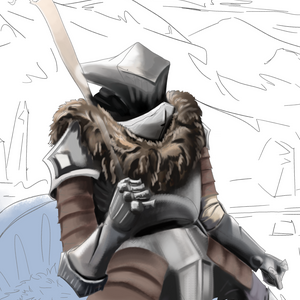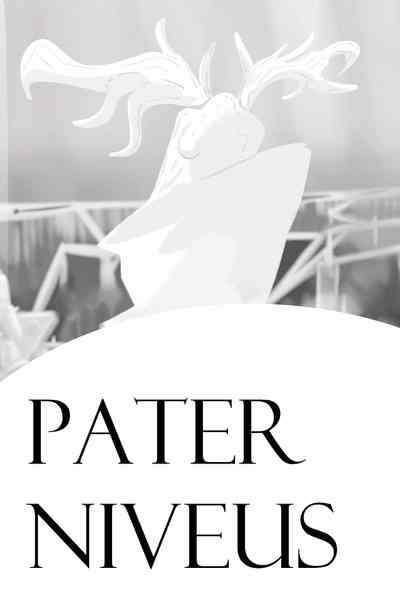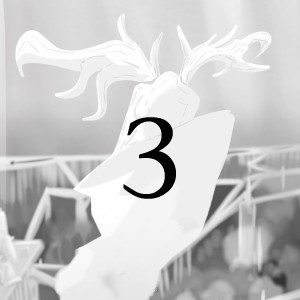- Chapter 3
Annemarie walked up to the entrance and knocked on the old oak door three times. The first time nobody answered, so Annemarie tried another time. She had time to pat of the snow on her clothes, but she forgot to after she heard a slight rustle inside. Annemarie waited. She could hear the other children playing behind her. She sighed and then she knocked for the third time. After another wait, there was finally a reaction. Annemarie could hear steps coming closer from behind the door. The heavy oak door opened. It was made to withstand the strongest winds and opened inwards, so it didn’t jam after heavy snowfall.
Annemarie hadn’t patted any snow off her jacket as she jumped through the door frame. Her mother caught her, and they hugged each other. Annemarie tried to hug her mother longer as her mother put her back down on the floor. Little clumps of snow still clung to Annemarie. She shouldn’t enter her home like this. But Annemarie was not thinking of it as her mother moved past her and closed the oak door. Annemarie stood there for a short while until her mother turned around and kneeled to Annemarie's height and said, “Annie, you know what I say.”
“Snow belongs outside, and you belong inside,” Annemarie completed. She pouted slightly. “Yes, yes, but I missed you so much,” Annemarie said and continued sheepishly, “I was so late, I feared you won’t be there."
Her mother caressed Annemarie’s head softly and patted the snow off her. Most of it had already fallen to the floor during the hug, but her mother liked things to be tidy. “Silly little girl, when am I not there where I say I am?” her mother continued.
“Never,” Annemarie answered, and then added, “but you can’t ever be too sure.”
“Yes, that is true,” her mother said. This mentality accompanied every step of her life as an engineer, but she dismissed any more thoughts about work. She missed her little darling too. “Now let's go inside and talk about what you’ve learned today,” her mother said, as she helped Annemarie take off her coats.
After the puffy jackets, soft gloves and long scarfs were hung up properly, her mother herded her into the living room. It took up most of the ground floor and was merged with the kitchen. On the backside of the living room, there was a door leading to the bathroom.
Annemarie could taste the stew her mother had been preparing and saw clean trails where her mother had cleaned the kitchen and living room. There was especially always a little layer of sot around the fireplace. But now, Annemarie could see a bright shine from the freshly polished stone hearth. Annemarie knew the stew would take some more time to finish but sat at the dining table. It was placed between the kitchen and the living room.
“So, what did you learn today?” Annemarie’s mother asked, and continued just as Annemarie tried to answer, “oh, I’m sorry, I've meant to ask how you’ve been the last days first.”
Personally, Annemarie would have preferred immediately talking about what she had learned. But she also felt assured by her mother’s second inquiry. Annemarie shifted nonchalantly on her chairs as she answered her mother’s muddled question. “I’m fine,” she said. Then after a short pause of deciding she returned the gesture, “And you? Did you do something interesting?” Annemarie wanted to talk about her own experiences, but she was also interested in her mother’s work. Annemarie was sure that something big had to be repaired in the past few days.
“Well,” Annemarie’s mother replied, “nothing big really. There have been some minor adjustments, but nothing big. Now how was your day?" It was a white lie; they had discovered multiple points of failure on the power plant. The ongoing repairs would make a good story, but her mother knew her daughter wanted to talk about her day more.
“Really? Ehm, can I talk about what I’ve learned?” Annemarie asked with gleaming eyes. As soon her mother nodded Annemarie started. “Well, where should I start? Uhm, so, we have looked at the architecture of the city buildings. Those covered in snow and ice at the far back of the horizon." Annemarie took out her schoolbooks and worksheets and retold what she had learned.
For the teacher, the architecture of the snowed-in buildings wasn’t directly important, but they tried to entice the children to learn more about their surroundings. Annemarie didn’t need such hooks to catch her attention. She had already been asking many questions. Only now, her classes funnelled her attention towards the history of their world.
The inner city was divided into rings and sections. The red marketplace was surrounded by red brick buildings or short, but stout stature. At the far horizon, grand towers of black glass could be seen if not too much snow fell. The space in-between the red marketplace and the towers made up of lumbering concrete blocks in monotonous rows. Now and then these concrete buildings sprouted blocky outgrowths. Other times the buildings’ heights jumped to many stories taller than before.
Annemarie had felt long ago that there must have been some decision behind those differences. Yet she could not fathom any sensible answer. The faraway buildings were repetitive and boring. Although there were differences in height or layout, each such change was accompanied by row upon row of the same design. Annemarie asked herself how such buildings had been built, but also why they had been built in such quantities. The surrounding landscape was many times larger than the little red brick settlement, but she strained to see anything more than a sea of grey cuboids. This had led Annemarie to ask one question to her parents weeks ago, “why would anybody build such a lacking landscape?”
Her father had answered, “maybe they wanted to build something different? It’s not all red brick and mortar, after all.” This was a fitting answer for her father. The capable engineer worked with many more materials.
Beneath the old and dusty floor of the marketplace, he had installed machines and uncountable piping. Annemarie’s mother had not been present on that day and the question hadn’t come up since then. Annemarie had already gone of wondering about other quirks of her surroundings, but as the theme of architecture came up again in school, she had asked her teacher the question again, “Uhm, why would anybody build such a lacking landscape?”
The teacher had agreed with Annemarie. The abandoned buildings did indeed seem to lack something fundamental. The teacher had taken some more time to think of an answer for Annemarie's question and then spoke, “maybe they did not have the time to decorate the exterior? After all, building this tall must be exhausting." It was a simplified half-truth, but it had given Annemarie something more to ponder over for a while. The last two days she had looked at the history of the ghost city. And she was happily babbling on about it to her mother.
“So,
do you see the outgrowth, here, here and here?" Annemarie asked her
mother speedily while pointing at a coal drawing of the building. Her
hasty movement smeared parts of her drawing and gave the building a
ghastly contour. “The teacher told me these are elevator shafts.
Elevators, can you believe it? From there to there. All twenty stories
up!” Annemarie let go of that picture and pulled out another sheet of
paper from school materials. “And this, this is one pain of glass as
long as the living room. Can you believe it?" Annemarie asked excitedly.
There were only a few elevators in the red settlement, but those did
only cover the meagre three stories of the redbrick buildings. She was
going through her drawings fast but had much more to speak about.











Comments (0)
See all